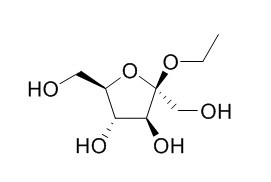Ethyl beta-D-fructofuranoside
Ethyl beta-D-fructofuranoside shows positive anti-tumor cells migration effects.
Inquire / Order:
manager@chemfaces.com
Technical Inquiries:
service@chemfaces.com
Tel:
+86-27-84237783
Fax:
+86-27-84254680
Address:
1 Building, No. 83, CheCheng Rd., Wuhan Economic and Technological Development Zone, Wuhan, Hubei 430056, PRC
Providing storage is as stated on the product vial and the vial is kept tightly sealed, the product can be stored for up to
24 months(2-8C).
Wherever possible, you should prepare and use solutions on the same day. However, if you need to make up stock solutions in advance, we recommend that you store the solution as aliquots in tightly sealed vials at -20C. Generally, these will be useable for up to two weeks. Before use, and prior to opening the vial we recommend that you allow your product to equilibrate to room temperature for at least 1 hour.
Need more advice on solubility, usage and handling? Please email to: service@chemfaces.com
The packaging of the product may have turned upside down during transportation, resulting in the natural compounds adhering to the neck or cap of the vial. take the vial out of its packaging and gently shake to let the compounds fall to the bottom of the vial. for liquid products, centrifuge at 200-500 RPM to gather the liquid at the bottom of the vial. try to avoid loss or contamination during handling.
Environ Toxicol.2023, 38(5):1174-1184.
Mol Neurobiol.2022, 02873-9.
Food Res Int.2022, 157:111207.
Inflammation.2020, 43(5):1716-1728.
Nutrients.2024, 16(19):3266.
Molecules.2016, 21(6)
Anticancer Res.2021, 41(3):1357-1364.
Evid-Based Compl Alt2020, 7202519:13
Int. J. of Food Properties2017, S108-S118
Int J Biol Macromol.2020, 169:342-351
Related and Featured Products
Bioresour Technol. 2013 Mar;132:365-9.
Purification of fructooligosaccharides by immobilized yeast cells and identification of ethyl β-D-fructofuranoside as a novel glycoside formed during the process.[Pubmed:
23186684]
A yeast strain (XS1) capable of selective utilization of fructooligosaccharides (FOSs) syrup was identified as Wickerhamomyces anomala.
METHODS AND RESULTS:
Cells of W. anomala XS1 were immobilized in calcium alginate and incubated with an FOS mixture at 30 °C. The purity of the FOS increased from 54.4% to 80.1% (w/w) as 93.6% of monosaccharides were metabolized while the oligosaccharides were not affected. The immobilized yeast cells could be recycled 10 times and the corresponding batch treatments achieved FOS purities around 80%.
CONCLUSIONS:
Thus, the method could be promising for large-scale purification of FOS syrup at low cost. A byproduct formed by the yeast was identified as Ethyl beta-D-fructofuranoside by MS and NMR spectroscopy.
J Biosci Bioeng. 1999;87(1):82-6.
Use of the yeast Hansenula polymorpha (Pichia angusta) to remove contaminating sugars from ethyl beta-D-fructofuranoside produced during sucrose ethanolysis catalysed by invertase.[Pubmed:
16232429]
Alkyl glycosides are interesting intermediates for the production of biodegradable surfactants.
Synthesis of Ethyl beta-D-fructofuranoside by invertase-catalysed ethanolysis of sucrose has been extensively reported in literature. However, this procedure yields mixtures of glucose, fructose, sucrose and Ethyl beta-D-fructofuranoside.
METHODS AND RESULTS:
Purification of Ethyl beta-D-fructofuranoside from such mixtures by chromatographic methods is laborious, difficult to scale up and requires organic solvents. The yeast Hansenula polymorpha grows rapidly on glucose, fructose and sucrose. Sucrose hydrolysis in this yeast is catalysed by an intracellular alpha-glucosidase ('maltase'); consequently, H. polymorpha should be unable to hydrolyse Ethyl beta-D-fructofuranoside. Indeed, aerobic cultivation of H. polymorpha on sugar mixtures obtained by invertase-catalysed ethanolysis of sucrose resulted in the complete removal of contaminating sugars, leaving Ethyl beta-D-fructofuranoside as the sole organic compound in culture supernatants.
CONCLUSIONS:
Pure Ethyl beta-D-fructofuranoside was recovered from the supernatants by mixed-bed ion exchange chromatography with an 86% yield.
Nat Prod Res. 2009;23(11):1013-20.
Fructose-derived carbohydrates from Alisma orientalis.[Pubmed:
19521916]
Nine fructose-derived carbohydrates were obtained from the methanol extract from the rhizome of Alisma orientalis.
METHODS AND RESULTS:
On the basis of spectroscopic analysis, their structures were determined to be alpha-D-fructofuranose (1), beta-D-fructofuranose (2), ethyl alpha-D-fructofuranoside (3), Ethyl beta-D-fructofuranoside (4), 5-hydroxymethyl-furaldehyde (5), sucrose (6), raffinose (7), stachyose (8) and verbascose (9), along with two oligosaccharides of manninotriose (10) and verbascotetraose (11). Compounds 3, 4 and 7-11 were isolated from this plant for the first time.
CONCLUSIONS:
A hypothetical biosynthesis pathway among these isolated carbohydrates (1-11) was briefly introduced.



